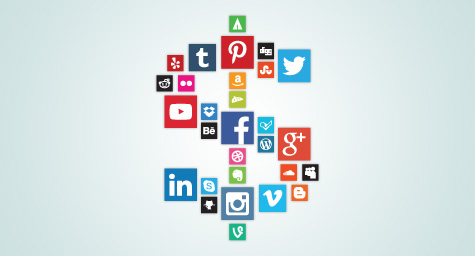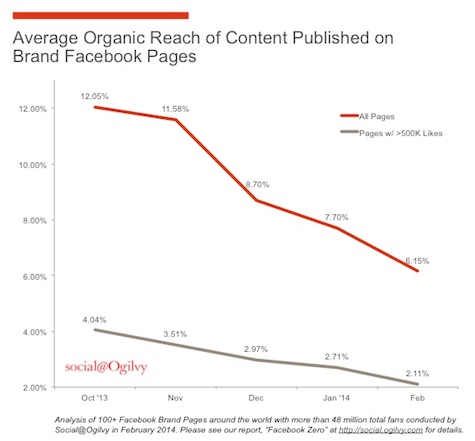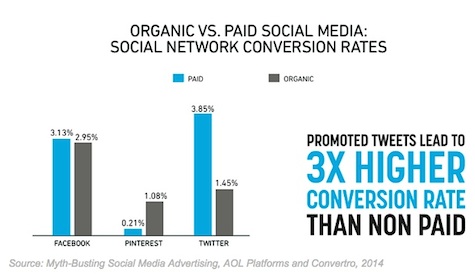Social Media is Now a Paid Marketing Platform. And That’s Great.
In 2012, an industry observer covering Facebook’s upcoming IPO wrote this about the company’s future: “Facebook needs to make money for their shareholders to make money… [So] how is Facebook going to make money? They have begun testing a feature where certain posts can get highlighted for a fee.”
That statement captured the expectation of most Facebook investors—the company had done a brilliant job of building a massive user base and now it was going to somehow cash in by charging advertisers to reach its audience.
Today, it’s clear that this assumption was correct and that Facebook’s execution of the strategy has succeeded spectacularly. In the second quarter of 2014, the company posted revenue of $2.9 billion—most of it coming from those “highlighted” (promoted) posts it had been testing two years ago.
Of course, for the shift to work, Facebook needed to make sure paid posts were more effective than organic posts. After all, if marketers could reach users by attracting Likes to their Pages and then messaging their fans directly, they would never need to pay Facebook to advertise.
So, not surprisingly, the company tweaked its algorithm over time to increasingly privilege paid posts over organic posts. At first the impact of these changes was slight, but recently it’s become huge—as many of us have seen firsthand.
Earlier this year, Ogilvy & Mather highlighted the trend in a report in which it examined the reach of organic Facebook posts made by 100 top brands. The analysis found organic reach has plummeted across the board, and the drop has been especially dramatic for large brands (500K+ likes).
Given the steady erosion in engagement, the report concluded: “Organic reach of the content brands publish in Facebook is destined to hit zero. It’s only a matter of time.”
That dire conclusion is somewhat of an overstatement. There are, and will remain, certain situations in which organic Facebook posts made by brands appear in people’s Facebook Feeds—for example, when a video becomes hugely popular and is shared extensively.
Still, the overall shift is pretty clear: social media marketing has evolved into a (mostly) paid channel.
To be clear, the trend is applicable to all social media networks. Facebook is the clearest example, because of its size and aggressive moves into paid promotion, but every major platform—from Twitter to Pinterest to (Facebook-owned) Instagram—is following the same path.
For many marketers, this evolution to “pay to play” seems like a terrible thing. Who wants to spend on reach you were once able to get for free? However, though it’s a bit counterintuitive, the move to a paid model has actually made social media a much more effective marketing channel.
In the heyday of organic reach it was exciting to build up fans/followers and be able to connect with them for free, but there was a huge flaw: it was difficult to figure out who these people were, and it was a struggle to engage them.
Put another way, being able to reach thousands (or hundreds of thousands, or millions) of people is great, but it only boosts sales if those are the right people.
Organic social engagement is usually a blunt instrument (with either zero or extremely limited targeting options)—marketers publish and pray that their content connects. Paid targeted reach, on the other hand, is precise.
For example, with its paid ads, Facebook offers an impressive mix of targeting criteria, including options for geographic location, demographics, interests, and behaviors. Moreover, there are a host of advanced strategies, such as custom audiences and retargeting, that allow for even more niche reach.
Again, this isn’t limited to Facebook. Other social media networks also increasingly offer sophisticated targeting options for their paid offerings.
The huge advantage of all this is better engagement with the desired audience. A recent study by AOL Platforms found promoted tweets on Twitter have a 3X higher conversion rate than non-paid tweets.
This increased conversion is partially due to prominence—promoted tweets appear more clearly and frequently in timelines—but it is also due to the fact that the tweets are now able to reach the right people.
Basically, marketers are not just paying the social networks to “play,” they are paying for the ability to precisely target their messages to current and prospective customers based on an ever-expanding range of criteria. This new exposure can even be amplified with “social endorsement” when users’ friends have liked or interacted with the brand.
Ultimately, advertisers are spending to reach the consumers who are most likely to be interested in their products. That increased effectiveness benefits not just the social networks, but everyone involved.
Leverage the power of social media marketing to boost the ROI of your digital advertising. Contact MDG today at 561-338-7797 or visit www.mdgsolutions.com.
MDG is a full-service advertising agency and one of Florida’s top branding firms. With offices in Boca Raton and New York City, MDG’s core capabilities include branding, logo design, print advertising, digital advertising, online advertising, mobile advertising, email marketing, media planning and buying, TV and radio, outdoor advertising, newspaper, video marketing, Web design and development, content marketing, social media marketing, and SEO. To discover the latest trends in advertising and branding, contact MDG today at 561-338-7797.



